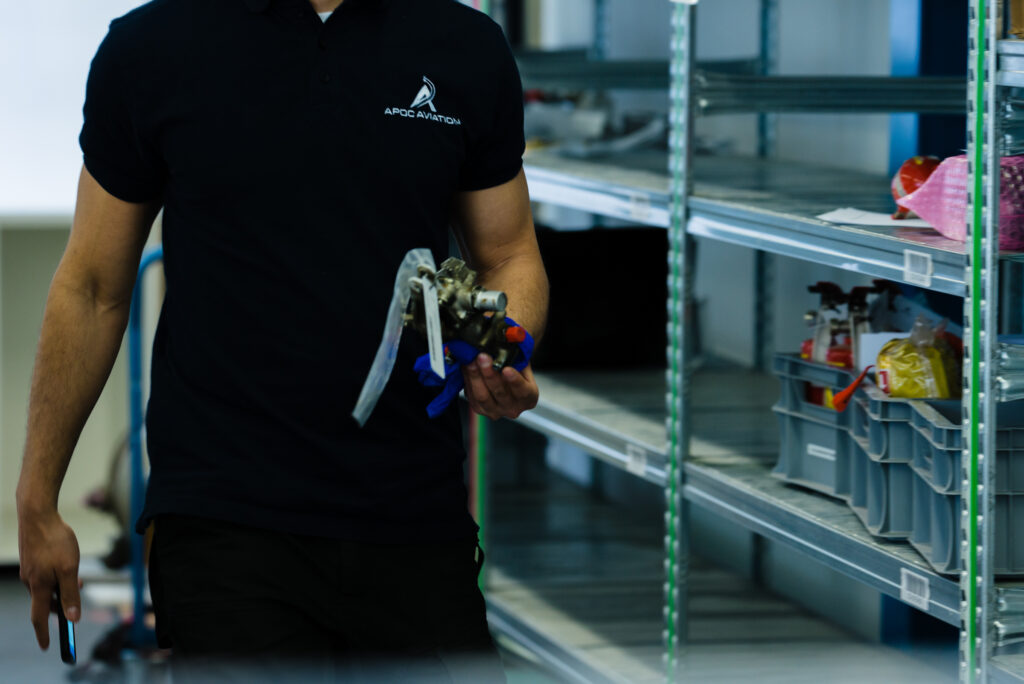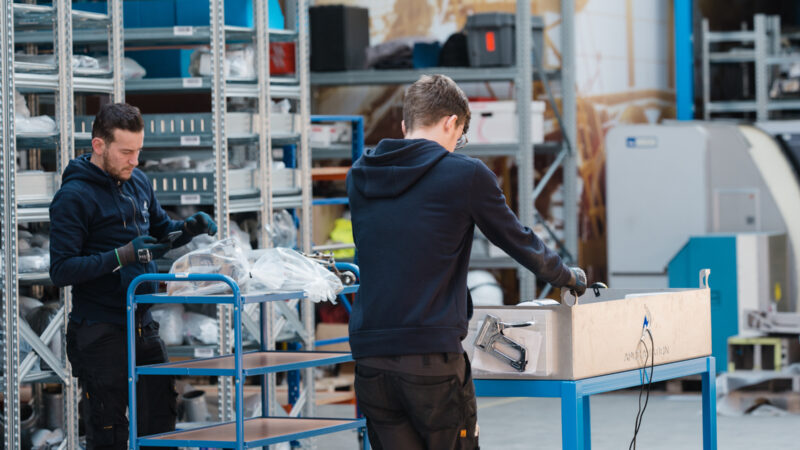Intelligent inventory management of spare aircraft parts can make a huge difference to an airline’s overall operation, as Bernie Baldwin discovers
Cash is king. Yes, most payment transactions these days are electronic, but having money in the bank ready for – sometimes emergency – transactions can certainly make life easier for a business. Tying up money in assets can be awkward when contingency funds are suddenly needed.
The field of aircraft spare parts inventory management highlights the occasions when having enough spares in house keeps the business running, but having too many can make life tricky by tying up capital.
It’s a tough task getting the right balance, and those charged with doing so – be they in-house airline maintenance departments or third-party MRO providers – have their views on the key elements for managing spare parts inventory.
Tracey Downes, head of component sales for APOC, confirms that there are a number of elements to consider. “One of the most important is to set up a profitable inventory management structure. With a proper system in place, airlines can reduce the capital burden of holding inventory and so free up cash flow,” she emphasises. “By working with a third-party parts supplier, airlines can consolidate their purchases while still ensuring access to aircraft parts as and when required.”
Downes continues: “Another essential aspect is to forecast the customer’s parts consumption and needs. The best way for an airline to overcome supply chain shortages is not with short-term fixes, but by taking a long-term perspective and accurately identifying their present and future needs for parts. Plan ahead by mapping out consumption requirements and forecast the parts needed to tie in with their longer-term company objectives. By identifying their parts procurement cycles in advance, while ensuring precise budget and capital flow planning, both airlines and manufacturers can optimise operations and free up their cash flow for other investments.”

Downes says it’s also important to consider how valuable the use of a good maintenance software programme can be to assist with managing spare parts inventory. “Although it is crucial to have a supply chain and inventory plan to avoid costly parts shortages, not many airlines can get it down just right, as it is tricky to formulate a strategy on their own in this unpredictable economic climate,” she says.
“At APOC, we are continually evolving our software and real-time stock data and we have positioned ourselves to exceed market predictions and expectations. We have a continual investment in software, which positions APOC as a frontrunner in the sector ready to support the renewed growth in the USM (used serviceable material) market.”
Likely to agree wholeheartedly with Downes’ suggestion to use a “good maintenance software programme” is Adam Frost, product manager for OASES. For him, a key element is for the organisation to know what materials are required for maintenance activities.
“In OASES [the application], each task can have the required material listed and specified as required or contingency against likely findings from the task,” Frost remarks. “In preparation of a maintenance input, the maintenance organisation can provision the required items and ensure they have access to the contingency material within their network of warehouses or at suppliers. Various material reports and the materials preload – where stock is provisioned for specific maintenance tasks – allow the airline to plan material in advance.”
During maintenance, the technicians might request further spare parts. Frost notes these requests may be made using OASES Mobile or OASES Desktop and are linked to the supply chain and logistics for sourcing and positioning, and follow the items until they are issued from stores to the aircraft. “Supplier performance statistics help the airline to ensure lead times are met and the quality of spare parts is maintained,” he comments.
“It is important to have a robust process for sourcing materials for deferred defects. Our ‘Carried Forward’ defect report lists all current defects and for each shows the materials requested along with their current disposition, including associated orders, expected delivery times and air waybill tracking. OASES’ ‘Shipping Workbench’ ensures material moving between warehouses and suppliers are controlled through preparation to receipt at their required destination.
“Also important is the need to maintain the traceability of spare parts to the source and provide easy access to certification documents. This can be attached to OASES stock records and helps maintenance technicians and auditors ensure compliance with regulations.”
As can be observed, both companies advocate assessment of the amount of stock customers should hold. “This is usually a decision for the airline, but OASES provides data to model usage and lead times to inform this,” Frost reports. “Holding stock of spare parts ties up capital and is effectively an insurance against delays, cancellations and providing serviceable aircraft on time from maintenance to facilitate the flying schedule.”
He adds: “There is a lot of variability between airlines and it can depend upon the aircraft types being operated, the age of their fleet, the nature of the operation, the operational network configuration and the local climate. For example, new aircraft are generally less hungry for spare parts and OASES’ ‘Warranty Workbench’ plays a significant role in the decision making. Older aircraft need more attention and require an efficient repair loop, although a proactive reliability programme can mitigate some unscheduled component changes.”
Minimum stock levels, both across the organisation and at specific warehouses with good visibility of shortages across the network, help the airline ensure there are sufficient spare parts available to support the flying programme, Frost notes. OASES users can assess minimum stock levels based on usage history.
All of this is done with a ‘green’ element, which ensures as little waste as possible while benefitting the owner of spare parts. “OASES Web has an ‘Unused Parts’ feature which allows materials managers to identify spare parts with no recent usage for redistribution or disposal. This helps make sure that the best value is extracted from the stockholding and allows capital tied up in unwanted inventory to be released back to the business,” Frost explains.

Downes says when it comes to assessing stock levels a customer should keep, the nature of the business and the continued need for maintenance visits, APOC works directly with airline customers’ maintenance planning departments to forecast inventory requirements.
“Understanding airline shop visit requirements each quarter is crucial as a reference and having supplies on hand to support these shop visits ensures smooth execution when supporting our customers,” she stresses.
The pandemic, Russia’s attack on Ukraine and other external factors have all played a role in the current state of supply chains. Airlines and MRO providers need to know that when inventory is removed from stocks, it can be replenished as rapidly as possible – thus preventing a potential AOG situation.
“Aircraft parts have the distinctive feature of being expensive and need to be handled within short cycle/turnaround times (TAT) in order to reduce inventory costs,” states Downes. “Aircraft inventory control is therefore a critical activity to ensure both effective maintenance and profitable use of multiple aircraft assets.
“If you know what, where and when a part is needed you can increase availability of the parts and reduce the stock in a ‘just in time’ manner. At APOC, our IT system shows real-time stock levels – actual live requirements backed up with minimum/maximum stock level control.
“As we continue to invest in narrowbody airframes, we use historic data to predict future requirements and ensure the typical units are in stock and ready to go, in line with our customers’ requirements.”
According to Frost, OASES provides a status of inventory versus minimum stock levels across the operational network. The application’s minimum stock level report takes into account what’s on order and any alternate part numbers along with their stock levels, thus being prepared for any quirks in the external supply chain. “We have a feature that can import and recommend re-order levels based on usage and turnaround times,” he confirms.
“Essential codes can be defined for each part number, so parts that will prevent the aircraft from being dispatched can be assessed more rigorously than those that don’t. Email notifications are provided on any event – issue of stock, picking, transfers – which causes a warehouse to sink below minimum levels.
“OASES has the concept of a central distribution warehouse, where stock can be easily transferred to outstation warehouses. OASES Web has a ‘Customs Tracking’ feature that ensures that all customs border-crossing shipments are identified and the customs details are recorded to ensure compliance with deferment account rules.”
External factors are not overlooked though. “Material controllers take a view of whether items currently on order – be it on repair, exchange or purchase – will sufficiently replenish stock to minimum, or whether further purchasing or perhaps loans are required to meet potential demand,” Frost comments.
“Pool agreements are a popular way to increase part availability and to access material quickly, although they are generally limited to one-for-one exchanges. Stock can also be taken on consignment from suppliers such that the stock is located near to where it may be needed. This reduces the lag caused by physically shipping the items from suppliers’ warehouses.”
While the challenges of the global aircraft parts supply chain are likely to continue to loom over the industry, planning in the manner described will help deliver smart inventory management – with some cash to spare.


